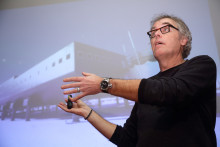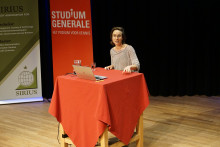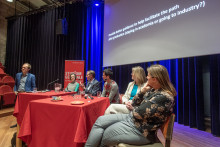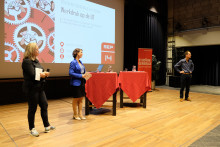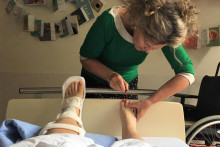Unhappy cyclists
Kerensa Broersen started with the Nobel Prize for medicine, which was awarded to Kaelin, Ratcliffe and Semenza, ‘for their discoveries of how cells sense and adapt to oxygen availability’. Broersen first gave a crash course in cell biology for beginners: cells need oxygen. ‘When a person exercises, is on high altitude or has too few red blood cells, there is not enough oxygen. The Nobel Prize winners studied cells in this state and discovered a protein that influences the production of EPO, a hormone which is also used as doping. Cyclists probably won’t be too happy about that’, she concluded.
Turning cosmology into science
Govert Schilling was next, with describing the two Nobel Prizes for physics. Two because, ‘If a cosmologist gets a Nobel Prize, it has to be in physics and then the physician gets mad’, Schilling jokingly explained. He started with the research of James Peebles and summarized the history of cosmology and told that ‘It was like philosophy; nobody took it seriously.’ Although, to this date, only 5% of space can be explained, Peebles got the Nobel Prize, ‘not for a special discovery, but for turning cosmology into science’.
Schilling went on with the second Prize that was awarded to Michel Mayor and Didier Queloz, ‘for the discovery of an exoplanet orbiting a solar-type star’. For long it was not known whether other suns also had planets, but in 1995 the first Exoplanet (a planet outside our solar system) was detected. It was a Jupiter-like planet that orbited its star within four days (the earth takes one year to orbit the sun). By measuring wobbling stars, it is now possible to know there are planets, even though you cannot see them. Since then, more than 4.000 more exoplanets have been discovered and the number of earthlike planets is huge. Water and life have not been detected yet, but according to Schilling ‘it won’t take long’.
Batteries
Finally, Mark Huijben explained the Nobel Prize for Chemistry, which was awarded to John Goodenough, Stanley Whittingham and Akira Yoshino, ‘for the development of lithium-ion batteries’. He explained that for most of the time, we only used Alkaline batteries, which aren’t rechargable. And when rechargeable batteries were invented, they were either with low voltage or still dangerous because of the liquid lithium. Huijben stated that ‘If a battery burns in a factory, they throw sand over it and then wait for a week.’ He added that the least safe type of battery is also used in Tesla cars. Now, however, a battery was invented with solid lithium, which is not explosive, and the voltage can only decrease in the moment of cutting it. With 97 years, Goodenough became the oldest Nobel laureate in history. When he won the Nobel Prize, he said: ‘don’t retire too early’.


